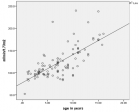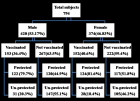Abstract
Research Article
Determinants of women’s perceived satisfaction on Antenatal care in urban Ghana: A cross-sectional study
Akowuah Jones Asafo* and Danquah Benedicta Adoma
Published: 02 July, 2019 | Volume 2 - Issue 2 | Pages: 038-053
Despite evidence on major interventions on the uptake and scale up of interventions meant to promote maternal health care services, little is known about adequate use of such program in urban Ghana among reproductive aged women. This study examined the determinants of women’s Satisfaction on antenatal care use in selected health facilities in the Kwabre East Municipality of Ghana. Using facility-based cross-sectional survey design, a three-stage sampling technique was conducted to sample 220 women attending postnatal care at selected public health facilities. Open-ended questionnaires were used to obtain data from respondents. Descriptive statistics and inferential statistics including binary logit regression model were used to analyze the data with the help of SPSS and STATA software. Logit analytical framework was computed to determine equations of variance. The association between antenatal care use and women’s satisfaction was determined and assessed using Pearson’s χ2 (2) test indicating 1% was run. Most women (92.7%) had at least four ANC visits during their entire pregnancy. The results indicate standard deviation of 7 with 81% regular ANC visits and 19% irregular. Most women (55%) received care by one caregiver, followed by women (35%) who received care by two caregivers and women (10%) who were cared for by three caregivers. The regression results showed varying utilization levels of 10%, 5% & 1% ANC satisfaction. System induced factors aimed at promoting maternal care use satisfaction are suggested.
Read Full Article HTML DOI: 10.29328/journal.cjog.1001022 Cite this Article Read Full Article PDF
Keywords:
ANC service; Postnatal care; Utilization; Satisfaction; Logit model; Urban Ghana
References
- Fotso JC, Ezeh AC, Essendi H. Maternal health in resource poor urban settings: how does women’s autonomy influence the utilisation of obstetric care services? Reprod Health. 2009; 6: 9. Ref.: http://bit.ly/303DVUF
- Oladapo OT, Osiberu MO. Do sociodemographic characteristics of pregnant women determine their perception of antenatal care quality? Matern Child Health J. 2009; 13: 505-511. Ref.: http://bit.ly/2YmLTrn
- Ntambue AM, Malonga FK, Dramaix-Wilmet M, Ngatu RN, Donnen P. Better than nothing? maternal, newborn, and child health services and perinatal mortality, Lubumbashi, democratic republic of the Congo: a cohort study. BMC Pregnancy Childbirth. 2016; 16: 89. Ref.: http://bit.ly/302RoMi
- Dahiru T, Oche OM. Determinants of antenatal care, institutional delivery and postnatal care services utilisation in Nigeria. Pan Afr Med J. 2015; 22: 1-17. Ref.: http://bit.ly/2xqecta
- World Health Organization and Unicef. Antenatal care in developing countries: promises, achievements and missed opportunities: an analysis of trends, levels and differentials. 2003; 1990–2001. Ref.: http://bit.ly/2FK26Qr
- World Health Organization. The World health report: 2005: make every mother and child count. 2005. Ref.: http://bit.ly/2RKNgxT
- World Health Organization. Maternal mortality: to improve maternal health, barriers that limit access to quality maternal health services must be identified and addressed at all levels of the health system: fact sheet (No. WHO/RHR/14.06). World Health Organization. 2014. Ref.: http://bit.ly/2J2PTZd
- Rani M, Bonu S, Harvey S. Differentials in the quality of antenatal care in India. Int J Qual Health Care. 2008; 20: 62-71. Ref.: http://bit.ly/2xmA0pJ
- Onyeajam DJ, Xirasagar S, Khan MM, Hardin JW, Odutolu O. Antenatal care satisfaction in a developing country: a cross-sectional study from Nigeria. BMC Public Health. 2018; 18: 368. Ref.: http://bit.ly/2xkPPwX
- Ghana Statistical Service. Ghana multiple indicator cluster survey with an enhanced malaria module and biomarker. Final Report. 2011. Ref.: http://bit.ly/2YrwCFQ
- World Bank. World databank; world development indicators. 2018; Ref.: http://bit.ly/2JfY0QN
- Overbosch GB, Nsowah-Nuamah NNN, Van den Boom GJM, Damnyag L. Determinants of antenatal care use in Ghana. Journal of African Economies. 2004; 13: 277-301. Ref.: http://bit.ly/2JhijgU
- Asundep NN, Carson AP, Turpin CA, Tameru B, Agidi AT, et al. Determinants of access to antenatal care and birth outcomes in Kumasi, Ghana. J Epidemiol Glob Health. 2013; 3: 279-288. Ref.: http://bit.ly/2NpXRQi
- Baffour-Awuah A, Mwini-Nyaledzigbor PP, Richter S. Enhancing focused antenatal care in Ghana: an exploration into perceptions of practicing midwives. Int J Africa Nurs Sci. 2015; 2: 59-64. Ref.: http://bit.ly/2FNIbQC
- D'Ambruoso L, Abbey M, Hussein J. Please understand when I cry out in pain: women's accounts of maternity services during labour and delivery in Ghana. BMC Public Health. 2005; 5: 140. Ref.: http://bit.ly/2FIMiNE
- Yakong VN, Rush KL, Bassett-Smith J, Bottorff JL, Robinson C. Women’s experiences of seeking reproductive health care in rural Ghana: challenges for maternal health service utilisation. J Adv Nurs. 2010; 66: 2431-2441. Ref.: http://bit.ly/2YkBug1
- National Population Commission, Nigeria, ICF International. Nigeria demographic and health survey 2013. 2014; Ref.: http://bit.ly/2FWLg0T
- Prytherch H, Kagoné M, Aninanya GA, Williams JE, Kakoko DC, et al. Motivation and incentives of rural maternal and neonatal health care providers: a comparison of qualitative findings from Burkina Faso, Ghana and Tanzania. BMC Health Services Research. 2013; 13: 149. Ref.: http://bit.ly/2Xcya5n
- Mannava P, Durrant K, Fisher J, Chersich M, Luchters S. Attitudes and behaviours of maternal health care providers in interactions with clients: a systematic review. Global Health. 2015; 11: 36. Ref.: http://bit.ly/2LwHPBh
- World Health Organization. Trends in maternal mortality: 1990-2015: estimates from WHO, UNICEF, UNFPA, World Bank Group and the United Nations Population Division: executive summary (No. WHO/RHR/15.23). World Health Organization. 2015; Ref.: http://bit.ly/2YnEvw0
- Bekele D, Bayu H, Beyene K, Bikila D. Women’s Satisfaction with Care Providers Interaction and Associated Factors among Pregnant Women Attending Antenatal Clinic in Tiyo District, Arsi Zone, Ethiopia, 2016: Institutional Based Cross-Sectional Study. Research & Reviews: Journal of Medical Science and Technology. 2017; 6: 30-38. Ref.: http://bit.ly/301u3ut
- Akowuah JA, Agyei-Baffour P, Awunyo-Vitor D. Determinants of antenatal healthcare utilisation by pregnant women in third trimester in peri-urban Ghana. J Trop Med. 2018; 2018: 1673517 Ref.: http://bit.ly/2ROBmmp
- Amu H, Nyarko SH. Satisfaction with Maternal Healthcare Services in the Ketu South Municipality, Ghana: A Qualitative Case Study. BioMed Research International. 2019; 2516469. Ref.: http://bit.ly/2RNF2VO
- Akowuah JA, Agyei-Baffour P, Asibey BO. A Qualitative Study on the Pathways to Evidence-Based Antenatal Care in Periurban Ghana. Obstetrics and gynecology international. 2018; 2018: 4381708. Ref.: http://bit.ly/326eQdo
- Kwabre East Health Directorate. Analyzes of Maternal Health Delivery. Kwabre East District Profile, 2013; Ref.: http://bit.ly/2J0bVeV
- Monette DR, Sullivan TJ, DeJong CR. Applied social research: A tool for the human services. Nelson Education; 2013; Ref.: http://bit.ly/2RYkKsy
- Burns AC, Bush RF. Marketing research. Globalization. 2006; 1: 4-8.
- Moser CA, Kalton G. Question wording. Research Design: The Logic of Social Inquiry. 2017; 140.
- Buor D. Determinants of utilisation of health services by women in rural and urban areas in Ghana. GeoJournal. 2004; 61: 89-102. Ref.: http://bit.ly/2XeKmT7
- Aseweh Abor P, Abekah-Nkrumah G, Sakyi K, Adjasi CK, Abo, J. The socio-economic determinants of maternal health care utilisation in Ghana. Int J Social Econo. 2011; 38: 628-648. Ref.: http://bit.ly/2J2tVoU
- Arthur E. Wealth and antenatal care use: implications for maternal health care utilisation in Ghana. Health economics review. 2012; 2: 14. Ref.: http://bit.ly/2J1psmC
- Shaikh BT, Hatcher J. Complementary and alternative medicine in Pakistan: prospects and limitations. Evid Based Complement Alternat Med. 2005; 2: 139-142. Ref.: http://bit.ly/308jtC2
- Girma F, Jira C, Girma B. Health services utilisation and associated factors in Jimma zone, South west Ethiopia. Ethiop J Health Sci. 2011; 21: 91-100. Ref.: http://bit.ly/2LsNdp4
- Dahiru T, Oche OM. Determinants of antenatal care, institutional delivery and postnatal care services utilisation in Nigeria. Pan Afr Med J. 2015; 21: 321. Ref.: http://bit.ly/2xqecta
- Ghana Health Service. The Health Sector in Ghana: Facts and Figures 2017. Accra: Government of Ghana, 2017; Ref.: http://bit.ly/2LHQEIH
- World Health Organization. WHO recommendations on antenatal care for a positive pregnancy experience. World Health Organization. 2016; Ref.: http://bit.ly/2Nt6RE7
- Lattof SR, Tunçalp Ö, Moran AC, Bucagu M, Chou D, et al. Developing measures for WHO recommendations on antenatal care for a positive pregnancy experience: a conceptual framework and scoping review. BMJ open. 2019; 9: e024130. Ref.: http://bit.ly/2J3ki9q
- Owolabi OO, Wong KL, Dennis ML, Radovich E, Cavallaro FL, et al. Comparing the use and content of antenatal care in adolescent and older first-time mothers in 13 countries of west Africa: a cross-sectional analysis of Demographic and Health Surveys. The Lancet Child & Adolescent Health. 2017; 1: 203-212. Ref.: http://bit.ly/2KQPknh
- Guagliardo MF. Spatial accessibility of primary care: concepts, methods and challenges. Int J Health Geogr. 2004; 3: 3. Ref.: http://bit.ly/2XvtaNW
- Chaibva CN. Factors influencing adolescents' utilisation of antenatal care services in Bulawayo, Zimbabwe. 2008; Ref.: http://bit.ly/2Xt33Cv
- Ministry of Health, Republic of Ghana. Health Sector Medium Term Development Plan 2014-2017. Accra: Government of Ghana, 2014; Ref.: http://bit.ly/2L3wvxj
- Vail J. Antenatal utilization, family planning and fertility preferences in Tari. Papua and New Guinea medical journal. 2002; 45: 134-141. Ref.: http://bit.ly/2S2GXpA
- Agboolah AR. Utilisation of antenatal care services in Atwima Nwabiagya District (Doctoral dissertation). 2009. Ref.: http://bit.ly/2KSixOB
- Cimiotti JP, Aiken LH, Sloane DM, Wu ES. Nurse staffing, burnout, and health care–associated infection. Am J Infect Control. 2012; 40: 486-490. Ref.: http://bit.ly/2Nt7jlN
- Okonofua F, Ogu R, Agholor K, Okike O, Abdus-Salam R, et al. Qualitative assessment of women’s satisfaction with maternal health care in referral hospitals in Nigeria. Reproductive health. 2017; 14: 44. Ref.: http://bit.ly/2KOQaAQ
- Greenaway ES, Leon J, Baker DP. Understanding the association between maternal education and use of health services in Ghana: exploring the role of health knowledge. J Biosoc Sci. 2012; 44: 733-747. Ref.: http://bit.ly/2XM7ZGV
- Nuraini E, Parker E. Improving knowledge of antenatal care (ANC) among pregnant women: a field trial in central Java, Indonesia. Asia Pac J Public Health. 2005; 17: 3-8. Ref.: http://bit.ly/2XFI186
- Tura G. Antenatal care service utilisation and associated factors in Metekel Zone, Northwest Ethiopia. Ethiopian Journal of Health Sciences. 2009; 19. Ref.: http://bit.ly/2LwHPSa
- Kambala C, Lohmann J, Mazalale J, Brenner S, De Allegri M, et al. How do Malawian women rate the quality of maternal and newborn care? Experiences and perceptions of women in the central and southern regions. BMC Pregnancy and Childbirth. 2015; 15: 1-19. Ref.: http://bit.ly/2NnnhOi
- Ghana Statistical Service (2004). Ghana. Statistical Service, Noguchi Memorial Institute for Medical Research and ORC Macro. MEASURE/DHS+ (Programme), 2004. Ghana demographic and health survey, 2003.
- Matua AG. Determinants of maternal choice for place of delivery in Ayivu county, Arua district, Uganda. Africa Journal of Nursing and Midwifery. 2004; 6: 33-38. Ref.: http://bit.ly/2LvkXlS
- Ziyani IS, King LJ, Ehlers VJ. Using triangulation of research methods to investigate family planning practice in Swaziland. Africa Journal of Nursing and Midwifery. 2004; 6: 12-17. Ref.: http://bit.ly/2LtMmEN
Figures:

Figure 1

Figure 2
Similar Articles
-
Focused Antenatal Care in urban Ghana: A qualitative study into physical accessibility of maternal health services in Kwabre East MunicipalityAkowuah Jones Asafo*,Kwarteng Bernard Owusu. Focused Antenatal Care in urban Ghana: A qualitative study into physical accessibility of maternal health services in Kwabre East Municipality. . 2019 doi: 10.29328/journal.cjog.1001023; 2: 054-066
-
Determinants of women’s perceived satisfaction on Antenatal care in urban Ghana: A cross-sectional studyAkowuah Jones Asafo*,Danquah Benedicta Adoma. Determinants of women’s perceived satisfaction on Antenatal care in urban Ghana: A cross-sectional study. . 2019 doi: 10.29328/journal.cjog.1001022; 2: 038-053
-
An audit on outpatient hysteroscopy – cervical dilatation, failure rates and patient satisfactionSophie Boyd*,S Lalchandani. An audit on outpatient hysteroscopy – cervical dilatation, failure rates and patient satisfaction. . 2021 doi: 10.29328/journal.cjog.1001076; 4: 003-006
-
Outpatient operative hysteroscopy: evaluation of patient satisfaction and acceptanceClare Margaret Crowley*,Noelle Gill,Minna Geisler. Outpatient operative hysteroscopy: evaluation of patient satisfaction and acceptance. . 2022 doi: 10.29328/journal.cjog.1001098; 5: 005-008
-
Septic Shock on Bartholinitis: Case Report and Modern Surgical ApproachesOumaima Fakir*,Hanaa Lazhar,Aziz Slaoui,Amina Lakhdar,Aziz Baydada. Septic Shock on Bartholinitis: Case Report and Modern Surgical Approaches. . 2025 doi: 10.29328/journal.cjog.1001183; 8: 015-018
Recently Viewed
-
Cystoid Macular Oedema Secondary to Bimatoprost in a Patient with Primary Open Angle GlaucomaKonstantinos Kyratzoglou*,Katie Morton. Cystoid Macular Oedema Secondary to Bimatoprost in a Patient with Primary Open Angle Glaucoma. Int J Clin Exp Ophthalmol. 2025: doi: 10.29328/journal.ijceo.1001059; 9: 001-003
-
Sex after Neurosurgery–Limitations, Recommendations, and the Impact on Patient’s Well-beingMor Levi Rivka*, Csaba L Dégi. Sex after Neurosurgery–Limitations, Recommendations, and the Impact on Patient’s Well-being. J Neurosci Neurol Disord. 2024: doi: 10.29328/journal.jnnd.1001099; 8: 064-068
-
Physiotherapy Undergraduate Students’ Perception About Clinical Education; A Qualitative StudyPravakar Timalsina*,Bimika Khadgi. Physiotherapy Undergraduate Students’ Perception About Clinical Education; A Qualitative Study. J Nov Physiother Rehabil. 2024: doi: 10.29328/journal.jnpr.1001063; 8: 043-052
-
Clinical Significance of Anterograde Angiography for Preoperative Evaluation in Patients with Varicose VeinsYi Liu,Dong Liu#,Junchen Li#,Tianqing Yao,Yincheng Ran,Ke Tian,Haonan Zhou,Lei Zhou,Zhumin Cao*,Kai Deng*. Clinical Significance of Anterograde Angiography for Preoperative Evaluation in Patients with Varicose Veins. J Radiol Oncol. 2025: doi: 10.29328/journal.jro.1001073; 9: 001-006
-
Regional Anesthesia Challenges in a Pregnant Patient with VACTERL Association: A Case ReportUzma Khanam*,Abid,Bhagyashri V Kumbar. Regional Anesthesia Challenges in a Pregnant Patient with VACTERL Association: A Case Report. Int J Clin Anesth Res. 2025: doi: 10.29328/journal.ijcar.1001027; 9: 010-012
Most Viewed
-
Evaluation of Biostimulants Based on Recovered Protein Hydrolysates from Animal By-products as Plant Growth EnhancersH Pérez-Aguilar*, M Lacruz-Asaro, F Arán-Ais. Evaluation of Biostimulants Based on Recovered Protein Hydrolysates from Animal By-products as Plant Growth Enhancers. J Plant Sci Phytopathol. 2023 doi: 10.29328/journal.jpsp.1001104; 7: 042-047
-
Sinonasal Myxoma Extending into the Orbit in a 4-Year Old: A Case PresentationJulian A Purrinos*, Ramzi Younis. Sinonasal Myxoma Extending into the Orbit in a 4-Year Old: A Case Presentation. Arch Case Rep. 2024 doi: 10.29328/journal.acr.1001099; 8: 075-077
-
Feasibility study of magnetic sensing for detecting single-neuron action potentialsDenis Tonini,Kai Wu,Renata Saha,Jian-Ping Wang*. Feasibility study of magnetic sensing for detecting single-neuron action potentials. Ann Biomed Sci Eng. 2022 doi: 10.29328/journal.abse.1001018; 6: 019-029
-
Pediatric Dysgerminoma: Unveiling a Rare Ovarian TumorFaten Limaiem*, Khalil Saffar, Ahmed Halouani. Pediatric Dysgerminoma: Unveiling a Rare Ovarian Tumor. Arch Case Rep. 2024 doi: 10.29328/journal.acr.1001087; 8: 010-013
-
Physical activity can change the physiological and psychological circumstances during COVID-19 pandemic: A narrative reviewKhashayar Maroufi*. Physical activity can change the physiological and psychological circumstances during COVID-19 pandemic: A narrative review. J Sports Med Ther. 2021 doi: 10.29328/journal.jsmt.1001051; 6: 001-007

HSPI: We're glad you're here. Please click "create a new Query" if you are a new visitor to our website and need further information from us.
If you are already a member of our network and need to keep track of any developments regarding a question you have already submitted, click "take me to my Query."




















































































































































